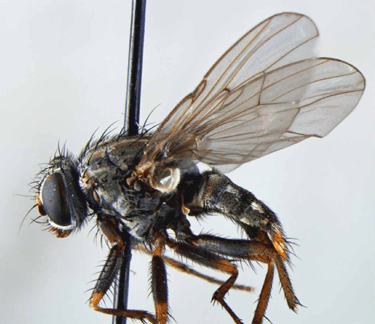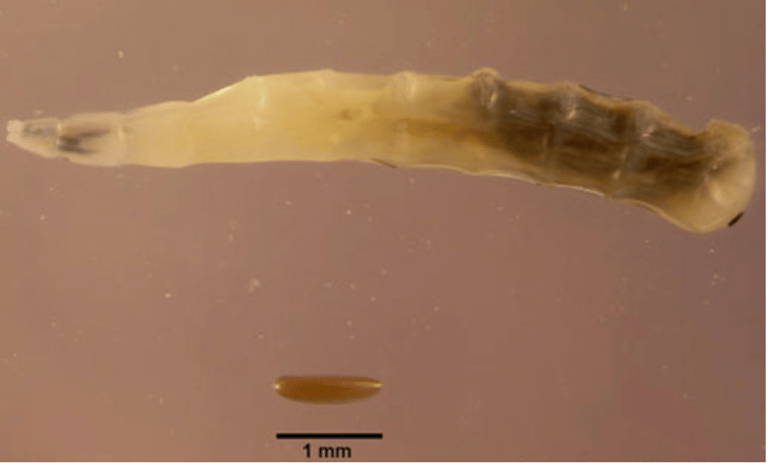Horn and House Flies
Perotti MA, Lysyk TJ, Kalischuk-Tymensen LD, Yanke LJ, & Selinger LB. 2001
Growth and survival of immature Haematobia irritans (Diptera: Muscidae) is influenced by bacteria isolated from cattle manure and conspecific larvae.
Journal of Medical Entomology 38, 180-187.
Twenty species of bacteria were isolated from cattle manure and seven species were isolated from the gut of larval horn fly Hematobia irritans (L.). Bacteria in manure belonged to the Bacillaceae, Pseudomonadaceae, Micrococcaceae, Corynebacteriaceae, Enterobacteriaceae, Microbacteriaceae, and two unassigned genera. Gut bacteria belonged to the Enterobacteriaceae, Bacillaceae, Neisseriaceae, and Pseudomonadaceae. H. irritans larval survival and growth on the various bacterial species were evaluated by rearing larvae in sterilized cattle manure that was inoculated with single bacterial isolates. H. irritans larvae failed to develop in sterilized, uninoculated manure, indicating that bacteria are necessary for larval development. Survival averaged 74 % in non-sterilized manure and ranged from 4 to 53 % in manure with individual isolates. Survival was highest when larvae were reared on manure inoculated with Pseudomonadaceae, Corynebacteriaceae, Micrococcaceae, and Bacillaceae and was lowest when reared in manure inoculated with Enterobacteriaceae and Microbacteriaceae. Pupal weights were heaviest when reared on the Flavobacteria, followed by the Pseudomonadaceae and Corynebacteriaceae. Pupae averaged 4.9 ± 0.08 mg when reared on gram-negative isolates, compared with 3.6 ± 0.09 mg when reared on Gram-positive isolates. Pupal weights were not significantly correlated with larval survival, indicating that bacteria that promote growth do not necessarily promote survival. A reproductive index was used as a measure of fitness and was highest for larvae reared in the nonsterile control, followed most closely by Pseudomonadaceae and Corynebacteriaceae. These groups appeared to best meet the nutritional requirements of larvae and may be used in further experiments to define an artificial rearing media for H. irritans.






Patitucci LD, Mariluis JC, & Aballay FH. 2011
A new species of the South American genus Arthurella Albuquerque (Diptera: Muscidae), with a key to species and new records.
Zootaxa 2810, 56-62.
The monotypic genus Arthurella Albuquerque, 1954 was originally described for A. nudiseta with a distribution restricted to Chile and Argentina. We add one new species, Arthurella choelensis sp. nov., from the central part of Argentina, and new distribution records for A. nudiseta. Biological and distributional information is given for both species. An identification key to the species of the genus is provided.
Perotti MA & Bachmann JA. 1999
First record and population ecology of the horn fly, Haematobia irritans (L.) (Diptera: Muscidae) on cattle from the south-east of Buenos Aires Province (Argentina).
Research and Reviews in Parasitology 59, 47-51.
Perotti MA & Lysyk TJ. 2003
Novel growth media for rearing larval horn flies, Haematobia irritans (Diptera: Muscidae).
Journal of Medical Entomology 40, 22-29.
Experiments were conducted to develop an agar-based medium for rearing immature horn flies, Hematobia irritans (L.). Larval survival was determined on sterilized manure inoculated with pure and mixed cultures of Acinetobacter sp., Bacillus pumilus Meyer & Gottheil, Comamonas acidovorans den Dooren de Jong, Pseudomonas mendocina Palleroni, Flavobacterium sp. and Empedobacter breve (Holmes & Owen). Rearing larvae on mixed cultures enhanced pupal weight but not survival. Horn fly larvae failed to survive when reared on standard bacteriological media inoculated with pure and mixed cultures of Acinetobacter sp., P. mendocina, and C. acidovorans. Larvae completed development on a minimal medium supplemented with alfalfa, egg proteins, and vitamins. Medium with low alfalfa content (30 g alfalfa/500 ml minimal medium) had enhanced survival when supplemented with egg yolk protein and vitamins. Medium with high alfalfa content (130 g alfalfa/500 ml minimal medium) had enhanced survival when supplemented with whole egg protein and vitamins. Survival was also favored when media were inoculated with pure cultures of Acinetobacter or Acinetobacter mixed with either Pseudomonas or Comamonas. Individual plates could support larvae developing from up to 40 eggs, and survival was least variable when plates were inoculated with greater numbers of eggs. This rearing system shows promise as a means for conducting standardized bioassays on a meridic diet.

